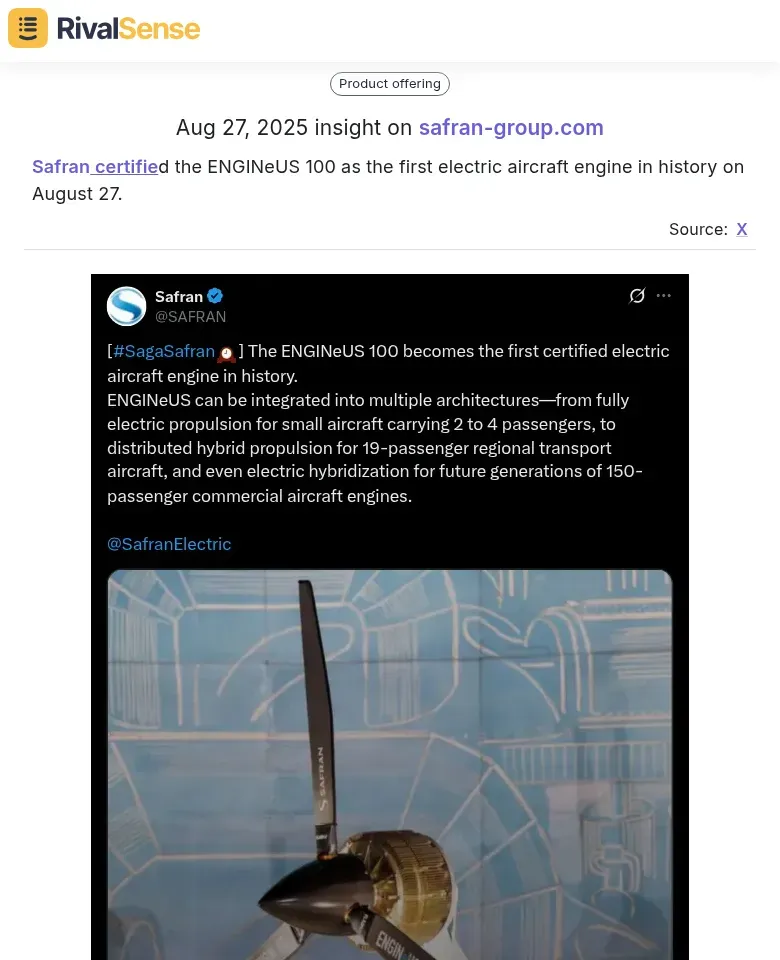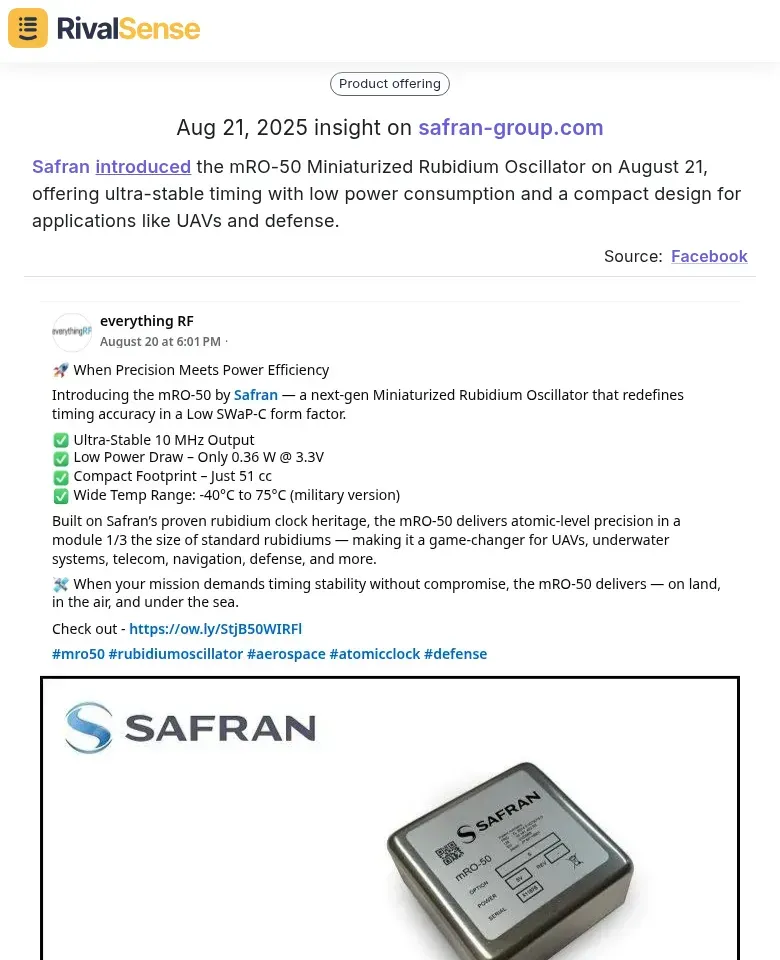7 Aviation Defense Productivity Boost Techniques: From Talent to Tech
Strategic talent acquisition and retention in aviation defense requires proactive competitor intelligence and targeted investment. Monitor competitor talent movements using tools like RivalSense to identify high-value recruitment opportunities when key personnel leave rival firms. Track LinkedIn updates, industry news, and patent filings to spot talent shifts before they become public knowledge.
For example, tracking executive movements can reveal strategic shifts:

Benjamin Madoc has joined Safran as Director, Purchasing and Supply Chain in the United Kingdom, previously holding the same position at Collins Aerospace.
This type of insight is valuable because it helps you anticipate supply chain strategy changes and identify potential recruitment opportunities when competitors experience leadership transitions.
For retention, develop personalized strategies for specialists with classified knowledge. Implement quarterly "stay interviews" to understand retention risks and create individual development plans. Offer competitive compensation packages that include 15-20% above-market base salaries, performance bonuses tied to project milestones, and long-term incentives like stock options or retention bonuses after 3-5 years.
Practical checklist:
- Set up competitor talent tracking alerts
- Create specialized career progression paths
- Offer continuous learning budgets ($5-10k annually)
- Implement flexible work arrangements for R&D teams
- Establish mentorship programs pairing junior staff with seasoned experts
Focus on creating an environment where technical experts can innovate while being competitively compensated.
Innovation-Driven Product Development and Market Positioning
In the aviation defense sector, innovation-driven product development requires strategic competitor analysis to identify emerging technology trends and market gaps. Monitor competitor product launches through defense industry publications, patent filings, and government contract announcements to spot patterns in AI integration, autonomous systems, and hypersonic technologies.
Tracking competitor certifications and milestones can reveal their innovation priorities:

Safran certified the ENGINeUS 100 as the first electric aircraft engine in history on August 27.
This insight is valuable because it helps you understand competitor technology breakthroughs and identify emerging market trends before they become mainstream.
Practical steps for first-to-market strategies:
- Create a competitor innovation timeline tracking system
- Set up alerts for competitor R&D announcements and prototype testing
- Analyze their technology adoption cycles (typically 3-5 years in defense)
- Identify 6-12 month windows where you can leapfrog their developments
For product roadmaps that counter competitor advancements:
- Build modular architectures that allow rapid technology insertion
- Develop dual-use technologies that serve both military and commercial markets
- Establish strategic partnerships with traditional defense primes for faster market entry
- Allocate 20-30% of R&D budget to disruptive technologies that competitors haven't prioritized
Key tip: Use defense-specific competitive intelligence tools that track DoD budget allocations and contract awards to anticipate where competitors are investing their innovation resources.
Supply Chain Optimization and Strategic Partnerships
Supply chain optimization in aviation defense requires strategic intelligence gathering and agile adaptation. Monitor competitor supply chain leadership changes using tools like RivalSense to identify potential partnership opportunities. When Lockheed Martin appointed Abby Lilly as CSCO in 2024, it signaled a renewed focus on sustainable supplier relationships—creating openings for aligned partners.
Tracking competitor product launches can reveal supply chain implications:

Safran introduced the mRO-50 Miniaturized Rubidium Oscillator on August 21, offering ultra-stable timing with low power consumption and a compact design for applications like UAVs and defense.
This type of insight is valuable because it helps you understand competitor component innovations that might affect supply chain requirements and partnership opportunities.
Develop agile supply chain strategies by tracking competitor procurement patterns. For example, when Boeing increased Phantom Works investments in 2023, suppliers who anticipated this shift gained first-mover advantages.
Implement a 3-step agility framework:
- Establish real-time competitor monitoring
- Create flexible supplier contracts with 30-60 day adjustment clauses
- Maintain strategic inventory buffers for critical components
Build strategic supplier relationships by analyzing competitor successes. Northrop Grumman's partnership with 12,000 suppliers demonstrates the power of diversified networks.
Practical tip: Use procurement pattern analysis to identify which suppliers consistently deliver for competitors, then approach them with value-added propositions rather than just price competition. Establish quarterly supplier innovation workshops to co-develop solutions that address common industry pain points, creating win-win partnerships that competitors can't easily replicate.
Technology Integration and Digital Transformation
In aviation defense, technology integration requires strategic competitor analysis to identify digital investment opportunities. Monitor competitor announcements for emerging technologies like AI-driven predictive maintenance, digital twins, and unmanned systems—areas where Lockheed Martin and Northrop Grumman are investing heavily.
Practical steps:
- Create a competitor technology tracking dashboard using tools like RivalSense to monitor R&D announcements, patent filings, and partnership deals
- Analyze competitor failures to avoid costly mistakes—many hypersonic projects faced setbacks due to thermal protection issues
- Leverage open-source intelligence from defense budget requests to identify funded technology priorities
- Develop rapid prototyping capabilities to test competitor-inspired innovations faster
- Implement cross-functional teams to reverse-engineer successful competitor implementations
Key insight: The DoD's $9.3B allocation for advanced technologies in FY2024 reveals priorities in AI, microelectronics, and quantum computing. Focus integration efforts where competitors are underinvesting but demand is growing, such as cybersecurity for unmanned systems or sustainable propulsion technologies.
Key Account Management and Customer Retention Strategies
In aviation defense, monitoring competitor account management personnel changes is crucial for identifying account vulnerabilities. When key account managers at rival firms leave or are replaced, relationships with defense clients may weaken, creating opportunities. Track these changes through LinkedIn alerts, industry news, and defense contract announcements. For example, if a competitor's senior account manager for a major defense contractor departs, immediately assess if their replacement lacks established relationships.
Develop proactive account defense strategies by analyzing competitor hiring patterns. If competitors are hiring specialists in cybersecurity or unmanned systems, they may be targeting accounts in those areas.
Create a checklist:
- Monitor competitor job postings monthly
- Analyze focus areas from their recent hires
- Identify which of your accounts align with their new capabilities
Differentiate through value-added services that competitors cannot easily replicate. Offer predictive maintenance analytics using AI, customized training programs for client teams, or integrated logistics support that reduces downtime.
Practical tip: Conduct quarterly value gap analysis comparing your services against top three competitors, then develop at least two unique value propositions annually.
Performance Measurement and Continuous Improvement
In aviation defense, establishing robust competitor benchmarking metrics is crucial. Track key indicators from public announcements: contract wins (e.g., Lockheed Martin's F-35 orders), R&D investments (Boeing's $3.2B in 2023), and production rates. Use tools like RivalSense to monitor competitor patent filings and regulatory submissions for early innovation signals.
Develop agile response mechanisms through cross-functional war rooms that meet weekly to assess competitor moves. Create a 48-hour response protocol for major competitor announcements, with predefined escalation paths and decision matrices. Implement digital dashboards showing real-time competitor positioning against your key accounts.
Establish continuous improvement cycles using competitor post-mortems. When rivals win major contracts, conduct deep-dive analyses on their bidding strategies, pricing models, and value propositions. Conversely, analyze competitor failures to identify market gaps. Implement quarterly 'competitive lessons learned' workshops where sales teams share frontline intelligence and adjust account strategies accordingly.
Practical Checklist:
- Monitor competitor earnings calls for strategic shifts
- Track hiring patterns in key technology areas
- Benchmark your response times against industry leaders
- Implement A/B testing for competitive counter-strategies
- Create competitor success/failure case study library
Ready to Boost Your Competitive Advantage?
Implementing these techniques requires consistent competitor monitoring and strategic analysis. RivalSense tracks competitor product launches/updates, pricing changes, event participations, partnerships, regulatory aspects, management changes, and media mentions across company websites, social media, and various registries—delivering everything in a comprehensive weekly email report.
Try RivalSense for free today and get your first competitor report to start gaining the strategic insights you need to outperform your competition in the aviation defense sector: https://rivalsense.co/
📚 Read more
👉 Event Intelligence Workflow: Uncover Competitor Strategies for Key Account Loyalty
👉 Business Partnership Best Practices: The Ultimate Strategic Guide for 2025
👉 Localize Semiconductor Partnerships: 5 Actionable Strategies for Growth
👉 How Barbour's Australia Expansion Triggered Competitive Responses (And How to Monitor Them)
